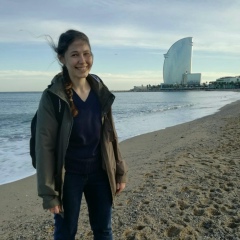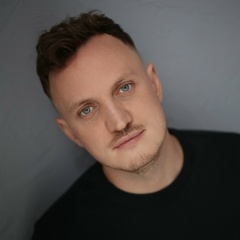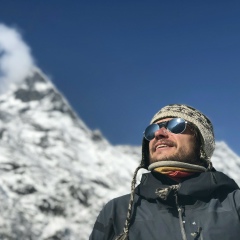Про судьбу
Интерес к биологии у меня проявился очень рано, я даже не помню, когда точно, может быть года в четыре, а может быть лет в пять. Помню, что когда я пошёл в школу, родители подарили мне шикарную и очень дорогую по тем временам книгу “Иллюстрированная энциклопедия насекомых” с огромным количеством фотографий, а это была уже далеко не первая научно-популярная книга о живой природе, подаренная родителями. До этого ещё были “Жизнь животных, 3 том, членистоногие”, “Школьный атлас определитель беспозвоночных” Олигера и Козлова и что-то ещё. Родители заметили интерес к этой теме, когда читали мне детские книги с картинками, одна из них была про бабочек, другая про обитателей морей и океанов.
Помимо того, что родители читали мне и сестре детские книги, они водили нас в самые разные музеи. Смутно припоминаю, что среди них были и Этнографический, и Военно-Морской музеи, и Ботанический сад при БИНе РАН. Но моим любимым музеем очень быстро стал Зоологический. Помню, как на выходных я начинал уговаривать родителей сопроводить меня туда. Причём ещё тогда, в далёком детстве, когда я был дошкольником, я не проявлял особого интереса к позвоночным животным, занимающим большую часть экспозиции. Уже тогда мне казалось, что все они выглядят довольно похоже и не очень интересно. Потому, оказавшись на втором этаже института, я тащил родителей к витринам с беспозвоночными. Про то, какие они бывают, я узнавал в научно-популярных книгах, одной из которых была “Мир живой природы”, вторая часть английской энциклопедии “Радость познания” (все эти книги я до сих пор бережно храню). “Мама, смотри, морская мышь! Смотри, какая сольпуга! А вон сипункулида!”. Мама, видя огромного толстого червяка в банке, хваталась за сердце. Но больше всего мне нравилась экспозиция насекомых на третьем этаже института, туда я впервую очередь и тащил родителей. К ним они относились более терпимо. С точки зрения родителей гладкие, блестящие, будто покрытые лаком, жуки выглядели довольно эстетично. Особенно меня привлекали гигантские тропические насекомые: тараканы, водные клопы белостоматиды и, больше всего, жуки: пластинчатоусые династины, тропические усачи и рогачи, бронзовки из трибы голиафини (жуки-голиафы).
Тогда я, конечно, ещё не думал про работу. Мечта стать учёным биологом пришла позже, уже в школе (в третьем классе я нарисовал себя на фоне доски, читающим лекции). Я поступил в Университет с желанием стать учёным-энтомологом. В тот момент я хотел заниматься только насекомыми и ничем другим. Но так вышло, что с насекомыми у меня не сложилось: ни на кафедре энтомологии, ни в лаборатории систематики насекомых Зоологического института Российской Академии Наук, сокращенно ЗИНа РАН (именно там находился любимый музей моего детства). Я бросил Университет, ушёл в академ, а потом и вовсе забрал документы и какое-то время работал в петербургском океанариуме. Но очень быстро я понял, что трачу свою жизнь впустую. Я смотрел на то, чем занимались мои бывшие товарищи по энтомологическому кружку. Они решали интересные задачи: находили необычных простейших, описывали новые виды. В итоге я стал студентом первого курса магистратуры на кафедре зоологии беспозвоночных СПбГУ, который изучал простейших. Мне нравилось большое количество мотивированной, увлечённой и в то же время интересной, разносторонней молодёжи на кафедре. Нравилась традиция преподавателей окружать студентов вниманием, заботой и поддержкой, обучать их всем необходимым методикам, помогать писать статьи и выступать на конференциях, а на защитах всячески поддерживать и защищать, даже если работа не получилась такой хорошей, как было задумано изначально. Помятуя свой неудачный опыт стать энтомологом-систематиком, я совсем не стремился в Зоологический институт, но вышло так, что диссертационный совет на биофаке закрыли, и я защищал кандидатскую в стенах ЗИНа. А год назад в том же ЗИНе открылась лаборатория Клеточной и Молекулярной Протистологии, куда меня пригласили работать старшим научным сотрудником. Так совершенно неожиданно я оказался сотрудником организации, куда в далёком детстве приходил с родителями и где я бегал с горящими глазами, разглядывая насекомых и других беспозвоночных.
Интерес к биологии у меня проявился очень рано, я даже не помню, когда точно, может быть года в четыре, а может быть лет в пять. Помню, что когда я пошёл в школу, родители подарили мне шикарную и очень дорогую по тем временам книгу “Иллюстрированная энциклопедия насекомых” с огромным количеством фотографий, а это была уже далеко не первая научно-популярная книга о живой природе, подаренная родителями. До этого ещё были “Жизнь животных, 3 том, членистоногие”, “Школьный атлас определитель беспозвоночных” Олигера и Козлова и что-то ещё. Родители заметили интерес к этой теме, когда читали мне детские книги с картинками, одна из них была про бабочек, другая про обитателей морей и океанов.
Помимо того, что родители читали мне и сестре детские книги, они водили нас в самые разные музеи. Смутно припоминаю, что среди них были и Этнографический, и Военно-Морской музеи, и Ботанический сад при БИНе РАН. Но моим любимым музеем очень быстро стал Зоологический. Помню, как на выходных я начинал уговаривать родителей сопроводить меня туда. Причём ещё тогда, в далёком детстве, когда я был дошкольником, я не проявлял особого интереса к позвоночным животным, занимающим большую часть экспозиции. Уже тогда мне казалось, что все они выглядят довольно похоже и не очень интересно. Потому, оказавшись на втором этаже института, я тащил родителей к витринам с беспозвоночными. Про то, какие они бывают, я узнавал в научно-популярных книгах, одной из которых была “Мир живой природы”, вторая часть английской энциклопедии “Радость познания” (все эти книги я до сих пор бережно храню). “Мама, смотри, морская мышь! Смотри, какая сольпуга! А вон сипункулида!”. Мама, видя огромного толстого червяка в банке, хваталась за сердце. Но больше всего мне нравилась экспозиция насекомых на третьем этаже института, туда я впервую очередь и тащил родителей. К ним они относились более терпимо. С точки зрения родителей гладкие, блестящие, будто покрытые лаком, жуки выглядели довольно эстетично. Особенно меня привлекали гигантские тропические насекомые: тараканы, водные клопы белостоматиды и, больше всего, жуки: пластинчатоусые династины, тропические усачи и рогачи, бронзовки из трибы голиафини (жуки-голиафы).
Тогда я, конечно, ещё не думал про работу. Мечта стать учёным биологом пришла позже, уже в школе (в третьем классе я нарисовал себя на фоне доски, читающим лекции). Я поступил в Университет с желанием стать учёным-энтомологом. В тот момент я хотел заниматься только насекомыми и ничем другим. Но так вышло, что с насекомыми у меня не сложилось: ни на кафедре энтомологии, ни в лаборатории систематики насекомых Зоологического института Российской Академии Наук, сокращенно ЗИНа РАН (именно там находился любимый музей моего детства). Я бросил Университет, ушёл в академ, а потом и вовсе забрал документы и какое-то время работал в петербургском океанариуме. Но очень быстро я понял, что трачу свою жизнь впустую. Я смотрел на то, чем занимались мои бывшие товарищи по энтомологическому кружку. Они решали интересные задачи: находили необычных простейших, описывали новые виды. В итоге я стал студентом первого курса магистратуры на кафедре зоологии беспозвоночных СПбГУ, который изучал простейших. Мне нравилось большое количество мотивированной, увлечённой и в то же время интересной, разносторонней молодёжи на кафедре. Нравилась традиция преподавателей окружать студентов вниманием, заботой и поддержкой, обучать их всем необходимым методикам, помогать писать статьи и выступать на конференциях, а на защитах всячески поддерживать и защищать, даже если работа не получилась такой хорошей, как было задумано изначально. Помятуя свой неудачный опыт стать энтомологом-систематиком, я совсем не стремился в Зоологический институт, но вышло так, что диссертационный совет на биофаке закрыли, и я защищал кандидатскую в стенах ЗИНа. А год назад в том же ЗИНе открылась лаборатория Клеточной и Молекулярной Протистологии, куда меня пригласили работать старшим научным сотрудником. Так совершенно неожиданно я оказался сотрудником организации, куда в далёком детстве приходил с родителями и где я бегал с горящими глазами, разглядывая насекомых и других беспозвоночных.
About fate
My interest in biology manifested itself very early, I do not even remember exactly when, maybe at four, and maybe at five. I remember that when I went to school, my parents gave me a gorgeous and very expensive for those times book “Illustrated Encyclopedia of Insects” with a huge number of photographs, and this was not the first popular science book about wildlife presented by parents. Before that, there were still “Animal Life, Volume 3, Arthropods”, “School Atlas Identifier of Invertebrates” by Oliger and Kozlov, and something else. Parents noticed an interest in this topic when they read me children's picture books, one of them was about butterflies, the other about the inhabitants of the seas and oceans.
In addition to the fact that my parents read children's books to me and my sister, they took us to various museums. I vaguely recall that among them were the Ethnographic and the Naval Museums, and the Botanical Garden at the BIN RAS. But the Zoological Museum very quickly became my favorite. I remember how on weekends I began to persuade my parents to accompany me there. Moreover, even then, in my distant childhood, when I was a preschooler, I did not show much interest in vertebrates, which occupy most of the exhibition. Even then, it seemed to me that they all looked quite similar and not very interesting. Therefore, when I was on the second floor of the institute, I dragged my parents to the display cases with invertebrates. I learned about what they are in popular science books, one of which was "The World of Wildlife", the second part of the English encyclopedia "The Joy of Cognition" (I still cherish all these books). “Mom, look, sea mouse! Look what a solpuga! And there is a sipunculida! ”. Mom, seeing a huge fat worm in the jar, clutched at her heart. But most of all I liked the exposition of insects on the third floor of the institute, where I first of all dragged my parents. They were more tolerant of them. From the parents' point of view, the smooth, shiny, as if varnished, the beetles looked quite aesthetically pleasing. I was especially attracted by giant tropical insects: cockroaches, water bugs belostomatids and, most of all, beetles: lamellar dynasties, tropical barbel and stag beetles, bronze from the tribe Goliathini (goliath beetles).
Then, of course, I hadn't thought about work yet. The dream of becoming a biologist came later, already at school (in the third grade I painted myself on the background of the blackboard, giving lectures). I entered the University with the desire to become an entomologist. At that moment I wanted to do nothing but insects and nothing else. But it so happened that I did not work out with insects: neither at the Department of Entomology, nor at the Laboratory of Insect Taxonomy of the Zoological Institute of the Russian Academy of Sciences, in abbreviated form ZIN RAS (it was there that my favorite museum of my childhood was located). I dropped out of the University, went to the academy, and then took my documents altogether and worked for some time at the St. Petersburg Oceanarium. But very quickly I realized that I was wasting my life. I looked at what my former comrades in the entomology circle were doing. They solved interesting problems: they found unusual protozoa, described new species. As a result, I became a first-year graduate student at the Department of Invertebrate Zoology at St. Petersburg State University, who studied protozoa. I liked the large number of motivated, enthusiastic and at the same time interesting, versatile youth in the department. I liked the tradition of teachers to surround students with attention, care and support, teach them all the necessary techniques, help write articles and speak at conferences, and support and protect them in every possible way, even if the work did not turn out as good as it was originally intended. Remembering my unsuccessful experience of becoming an entomologist-taxonomist, I did not at all strive to go to the Zoological Institute, but it turned out that the dissertation council at the biology faculty was closed, and I defended my Ph.D. within the walls of ZIN. A year ago, in the same ZIN, a laboratory of Cellular and Molecular Protistology was opened, where I was invited to work as a senior researcher. So, quite unexpectedly, I found myself an employee of the organization, where in my distant childhood I came with my parents and where I ran with burning eyes, looking at insects and other invertebrates.
My interest in biology manifested itself very early, I do not even remember exactly when, maybe at four, and maybe at five. I remember that when I went to school, my parents gave me a gorgeous and very expensive for those times book “Illustrated Encyclopedia of Insects” with a huge number of photographs, and this was not the first popular science book about wildlife presented by parents. Before that, there were still “Animal Life, Volume 3, Arthropods”, “School Atlas Identifier of Invertebrates” by Oliger and Kozlov, and something else. Parents noticed an interest in this topic when they read me children's picture books, one of them was about butterflies, the other about the inhabitants of the seas and oceans.
In addition to the fact that my parents read children's books to me and my sister, they took us to various museums. I vaguely recall that among them were the Ethnographic and the Naval Museums, and the Botanical Garden at the BIN RAS. But the Zoological Museum very quickly became my favorite. I remember how on weekends I began to persuade my parents to accompany me there. Moreover, even then, in my distant childhood, when I was a preschooler, I did not show much interest in vertebrates, which occupy most of the exhibition. Even then, it seemed to me that they all looked quite similar and not very interesting. Therefore, when I was on the second floor of the institute, I dragged my parents to the display cases with invertebrates. I learned about what they are in popular science books, one of which was "The World of Wildlife", the second part of the English encyclopedia "The Joy of Cognition" (I still cherish all these books). “Mom, look, sea mouse! Look what a solpuga! And there is a sipunculida! ”. Mom, seeing a huge fat worm in the jar, clutched at her heart. But most of all I liked the exposition of insects on the third floor of the institute, where I first of all dragged my parents. They were more tolerant of them. From the parents' point of view, the smooth, shiny, as if varnished, the beetles looked quite aesthetically pleasing. I was especially attracted by giant tropical insects: cockroaches, water bugs belostomatids and, most of all, beetles: lamellar dynasties, tropical barbel and stag beetles, bronze from the tribe Goliathini (goliath beetles).
Then, of course, I hadn't thought about work yet. The dream of becoming a biologist came later, already at school (in the third grade I painted myself on the background of the blackboard, giving lectures). I entered the University with the desire to become an entomologist. At that moment I wanted to do nothing but insects and nothing else. But it so happened that I did not work out with insects: neither at the Department of Entomology, nor at the Laboratory of Insect Taxonomy of the Zoological Institute of the Russian Academy of Sciences, in abbreviated form ZIN RAS (it was there that my favorite museum of my childhood was located). I dropped out of the University, went to the academy, and then took my documents altogether and worked for some time at the St. Petersburg Oceanarium. But very quickly I realized that I was wasting my life. I looked at what my former comrades in the entomology circle were doing. They solved interesting problems: they found unusual protozoa, described new species. As a result, I became a first-year graduate student at the Department of Invertebrate Zoology at St. Petersburg State University, who studied protozoa. I liked the large number of motivated, enthusiastic and at the same time interesting, versatile youth in the department. I liked the tradition of teachers to surround students with attention, care and support, teach them all the necessary techniques, help write articles and speak at conferences, and support and protect them in every possible way, even if the work did not turn out as good as it was originally intended. Remembering my unsuccessful experience of becoming an entomologist-taxonomist, I did not at all strive to go to the Zoological Institute, but it turned out that the dissertation council at the biology faculty was closed, and I defended my Ph.D. within the walls of ZIN. A year ago, in the same ZIN, a laboratory of Cellular and Molecular Protistology was opened, where I was invited to work as a senior researcher. So, quite unexpectedly, I found myself an employee of the organization, where in my distant childhood I came with my parents and where I ran with burning eyes, looking at insects and other invertebrates.


У записи 33 лайков,
0 репостов,
515 просмотров.
0 репостов,
515 просмотров.
Эту запись оставил(а) на своей стене Илья Удалов






















































